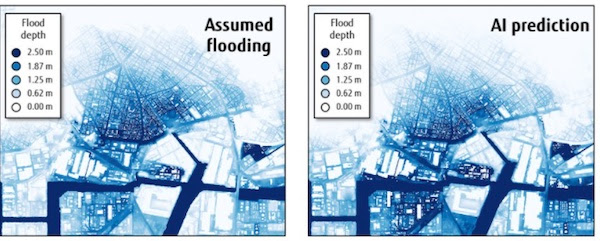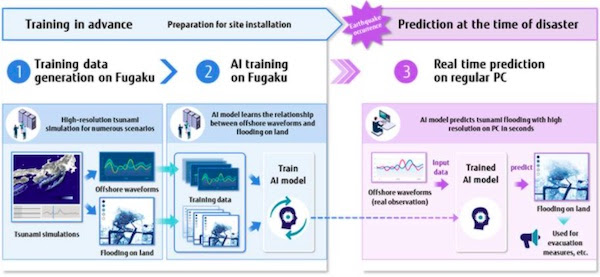The International Research Institute of Disaster Science at Tohoku University, the Earthquake Research Institute at the University of Tokyo, and Fujitsu Laboratories have today announced the successful development of an AI model that will empower disaster management teams with the ability to predict tsunami flooding in coastal areas in near real-time, harnessing the computational power of the world’s fastest supercomputer(1), Fugaku, jointly developed by RIKEN and Fujitsu.


As part of the joint initiative, numerous
high-resolution tsunami simulations were carried out using Japan’s
flagship supercomputer Fugaku. A new AI model was then created using
simulated offshore tsunami waveforms and coastal flooding conditions as
training
data.
In the event of an actual earthquake, inputting tsunami waveform data
observed offshore into this newly created AI model will allow for
predictions of flooding conditions in coastal areas before landfall at
high spatial resolution. This will make it possible
to more accurately and rapidly obtain detailed flooding forecast data
for specific areas, offering critical insights into the effects of
localized waves on surrounding infrastructure like buildings and roads
in coastal urban areas. Furthermore, the AI model,
trained in advance with Fugaku, can be run in seconds on ordinary PCs,
making it much easier to build practical, real-time flood prediction
systems, which previously required supercomputers. Ultimately, this
technology offers the potential for disaster management
teams to make near real-time, data-driven disaster mitigation and
evacuation measures.
Background and Challenges
In March 2011, The Great East Japan Earthquake triggered a massive
tsunami that inflicted catastrophic damage in the Tohoku region along
the eastern coast of Japan, throwing the challenges of disaster
mitigation efforts into painful relief. This tragic event
revealed that many issues remain from the viewpoint of acquiring and
utilizing information for efficient and safe evacuation in the event of a
disaster.
Tsunami prediction represents one key area in this respect, requiring
the development of technologies to allow authorities to quickly obtain
accurate and detailed information to help disaster management teams
mitigate damage by ordering appropriate evacuation
actions. Since the Great East Japan Earthquake, the tsunami observation
network in Japanese coastal waters has been significantly strengthened
to this end, while the development of highly-accurate tsunami prediction
technologies in coastal areas that leverage
real-time off-coast tsunami observation data has been promoted as an
urgent priority.
Conventionally, coastal tsunami predictions have been mainly based on
the method of selecting the data with the most similar earthquake and
tsunami occurrence conditions compared with observations from databases
prepared in advance by simulations, and the method
of gradually adjusting coastal tsunami predictions to be consistent
with offshore tsunami observations. In both cases, simulation
calculations for flood predictions rely on large-scale supercomputers or
database searches, which makes it difficult to implement
and operate a feasible prediction system.
About the Newly Developed Technology and Initiative
To resolve this, Fujitsu, Tohoku University, and The University of Tokyo
worked to jointly develop a high-resolution AI technology that can
instantaneously predict tsunami flooding by utilizing the pre-shared
evaluation environment of Fugaku in the research
subject “Exascale AI based Tsunami Forecast to Predict the
Unpredicted”(2) selected in the FY 2020 Fugaku Preliminary Use
Projects(3) solicited by Research Organization for Information Science
and Technology.
By leveraging the exceptionally fast computing power of the
supercomputer Fugaku, the project members generated training data for
20,000 possible tsunami scenarios based on high-resolution simulations
in three-meter units. By training an AI model with these
20,000 data sets, it was possible to build an AI model that can predict
the flooding of land areas with similarly high resolution from tsunami
waveform data observed offshore at the time of an earthquake.
For the AI model, a new deep learning technology was developed, with a
two-stage configuration of AI that first approximates the flooding
situation on land in rough resolution from the tsunami waveforms
observed offshore. Then, the AI is applied to increase
the resolution of the estimated flooding conditions and optimizes
calculation performance for learning in Fugaku. Normally, computers
suitable for simulation and computers suitable for AI are different, but
with this initiative, the project members were able
to leverage the special features(4) of Fugaku to greatly streamline the
creation of AI for high-precision tsunami prediction by using training
data generated on Fugaku as is for machine learning. Namely, Fugaku
offered the project members a powerful resource
that delivers high performance in both simulation as well as AI
applications.
When this technology was applied to the case of tsunami flooding
prediction in Tokyo Bay caused by a theoretical, massive Nankai Trough
earthquake, it was confirmed that highly accurate prediction was
possible using a regular PC in a matter of seconds for a
variety of different tsunami scenarios, including the tsunami model(5)
assumed by the Cabinet Office of Japan (Fig. 2 & Fig. 3).
By further utilizing the large scale, high speed performance of Fugaku
in the future, while simultaneously training the system with additional
tsunami scenarios, the partners can help to realize AI that can offer
predictions for unexpected tsunami and flooding
predictions over a wider area.


